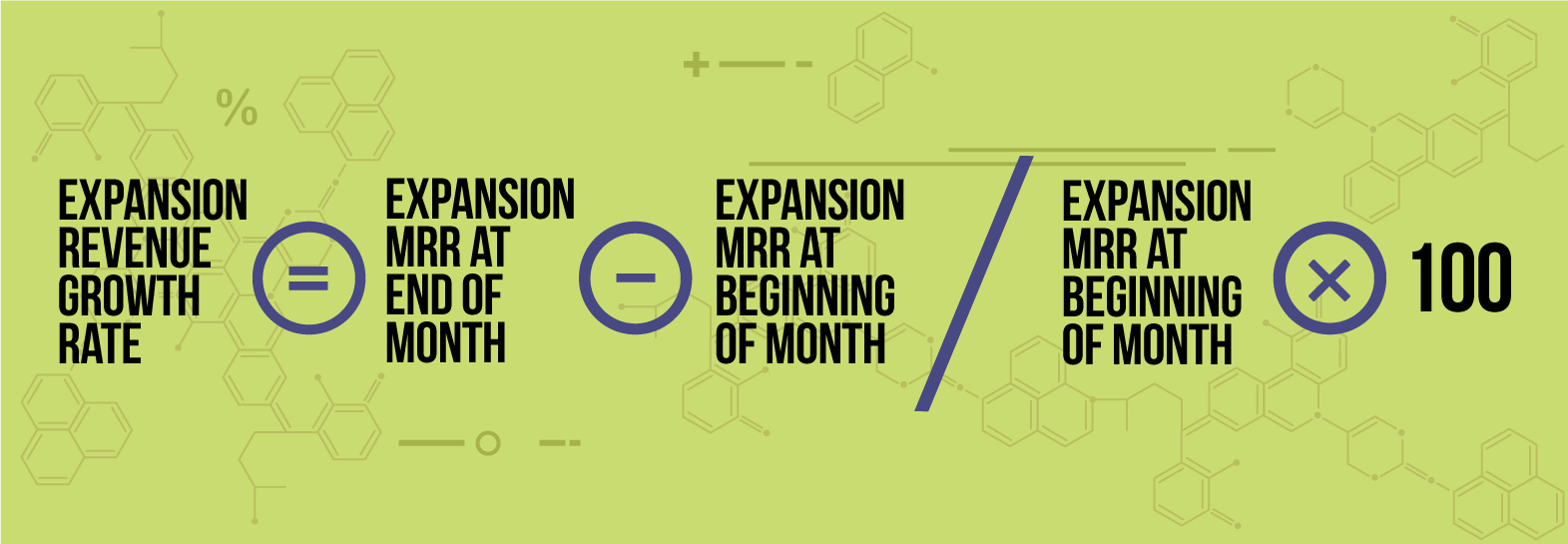SaaS companies often fixate on acquiring new customers.
In a major study of SaaS articles published online, Profitwell found that seven out of ten were focused on net-new acquisition, while fewer than one out of ten were focused on the monetization of existing customers. This is surprising, because ongoing SaaS growth depends as much on maintaining and growing sales within your existing customer base as it does with acquiring new subscribers.
The additional revenue you can generate from existing customers beyond initial fees is known as expansion revenue. This is a critical factor in long-term SaaS success, because it’s a more cost-effective way of expanding business than acquiring new customers. When expansion revenue generates more than is lost by churn, the resulting negative churn can generate substantial and sustained growth.
Expansion revenue is typically calculated on a cohort basis, and the growth rate is often calculated at the end of each month. The formula for expansion revenue growth is as follows (MRR stands for “monthly recurring revenue”):

While this might seem simple, keeping track of these numbers for multiple cohorts can get complex as you gather more data over time. If you’re serious about monitoring this data (and every SaaS company with growth ambitions should be), you might want to look into an analytics dashboard capable of cohort analysis.
As a SaaS company grows its user base, a constant churn rate becomes an increasingly significant problem for continued growth. The reason for this is that the growth in churn is geometric, while new customer acquisition is linear. As a result, it becomes impossible to offset churn purely by expanding your customer base.
That might sound a little abstract, so here’s an example. Take a SaaS company that’s able to acquire $1,000 in new customer MRR each month, with a churn rate of 5%. Here’s what will happen:
As you can see from just the first three months, the growth rate is already starting to be weighed down by churn, which is growing rapidly in absolute terms. Even worse, by the time this company hits $20,000 in MRR, the growth rate would have gone down to zero.
While the exact numbers will differ for each SaaS company, the trend is identical. This leads to an important conclusion: There is no way to build a sustainable SaaS business on new customer acquisition alone.

The way out of this conundrum is to focus on minimizing churn and growing expansion revenue instead. The reason expansion revenue is so compelling is because it allows you to grow MRR at a much lower cost than acquiring a new customer.
A 2013 survey of SaaS companies by Pacific Crest found that the cost of customer acquisition (CAC) was $0.92 per dollar of customer lifetime value (CLV). In contrast, each incremental dollar of CLV obtained through revenue expansion only cost $0.17. That is an enormous difference – it means generating revenue from existing customers costs a mere 19% of revenue from new customers!
This wasn’t just a fluke, either. The study was repeated in 2015, and found similar results, though increasing competition had brought all revenue acquisition costs up. Each dollar of new customer revenue now costs $1.18, while each dollar of revenue expansion costs $0.28.
The fact remains, however, that revenue expansion is still far superior as a method of increasing MRR. This is widely recognized by venture capitalists and potential acquirers as well. As Tom Tunguz of Redpoint Ventures observes, “The highest correlated factor to post-money valuations for Series A SaaS companies isn’t revenue or revenue growth, but negative churn. Revenue growth correlates to post-money with a 0.18 R2. Revenue correlates at 0.3 R2. Negative churn, or account expansion, correlates at 0.54 R2.”
While not every SaaS company is looking to get acquired or line up VC funding, these detailed numbers from veteran industry observers show just how valuable revenue expansion can be.
There are four main strategies for growing expansion revenue.
The first is to raise prices. However, it’s critical to make sure any gains in revenue from a price increase isn’t offset by an increase in churn. There are a few ways you can determine how a price increase will affect demand but usually, if a price increase is kept marginal and customers are getting value, it can have a positive impact on your expansion revenue.
The second way is to create upgrade opportunities. Every SaaS company should examine having a pricing model that includes multiple tiers tied for different levels of value. Different levels of value could be premium features or usage and results-based. For instance, Wistia has different account tiers based on the number of videos hosted, while Dropbox charges customers by the amount of storage space used.
In many cases, customers will initially start using your software because they are interested in the core features. But as they become more comfortable with your software and start using it more heavily, they will often develop a need for more advanced functionality. This provides you with a natural opportunity to offer those premium features at a higher price.
The third way is to cross-sell other products. Many of your customers will have bought from you due to the appeal of one particular product, and may not even be aware of your other offerings. You should take advantage of this by educating them on related solutions that might be of value.
Compared to the previous two methods, cross-selling requires more work, because you actually have to sell your customers on the benefit of a separate product – and one often designed to solve a different problem. This means that the individual buyer of the first product can be different from the buyer of the second product. For instance, a CRM solution is likely to be purchased by the VP of sales, but the marketing automation software that integrates with it is likely to be the domain of marketing. Because of this dynamic, effective cross-selling often requires the development of different buyer personas and separate marketing collateral.
The fourth way is to sell non-software products. There is nothing that says that SaaS companies have to limit themselves to software. Often, many companies will have built up significant domain expertise in their target industry, and will be able to monetize that expertise in various ways. Common examples include detailed research reports and how-to guides, or training and advisory services. For some SaaS companies, it might also make sense to offer premium support packages. This can work especially well if there is an open-source component to your software offering.
In business, it’s often said that “what got you here won’t get you there.” Nowhere is this more true than in SaaS growth. Initially, SaaS companies often find it most productive to expand by acquiring new customers, but over time, this strategy will cause their growth to plateau. In order to truly achieve sustainable, long-term growth, companies need to focus on expanding revenue from existing customers as well.
[pardot-form width="100%" height="280" id="11140" title="Blog Form: More Ways to Make Money Infographic"]